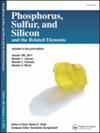CuO与AlPO4骨架的杂化制备新型CuO-AlPO4纳米多孔材料
IF 1.6
4区 化学
Q4 CHEMISTRY, INORGANIC & NUCLEAR
Phosphorus, Sulfur, and Silicon and the Related Elements
Pub Date : 2025-08-23
DOI:10.1080/10426507.2025.2551070
引用次数: 0
摘要
全球变暖和二氧化碳分解是相互关联的,因为二氧化碳是导致全球变暖的主要因素。缓解全球变暖的一个潜在方法是分解二氧化碳,将氧气释放到大气中。为了分解CO2,我们以四丙基氢氧化铵为模板合成了CuO-AlPO4。通过XRD、FT-IR、BET、TGA、TPD和TEM等分析对其进行了表征。XRD结果证明,新型CuO-AlPO4由两种晶体体系组成,形成了杂化骨架。磷酸铝呈四面体结构,在CuO中,Cu2+离子与四面体氧(O2−)呈线性配位。因此,在O2−和Cu2+离子之间存在电荷转移跃迁,紫外可见光谱证实了这一点。这种杂化框架的形成可能受到模板分子取向的影响。框架的杂化促进了氧化离子(O2−)的生成,与以前的文献相比,氧化离子在较低的温度下分解CO2具有高活性。最大CO2转化率和氧选择性分别为98%和91%。本文章由计算机程序翻译,如有差异,请以英文原文为准。
Hybridization of CuO and AlPO4 framework to produce a novel nanoporous material of CuO-AlPO4
Global warming and CO2 decomposition are interconnected, as CO2 is a major contributor to global warming. One potential approach to mitigating global warming is decomposing CO2 to release oxygen into the atmosphere. In order to decompose the CO2, we have synthesized CuO-AlPO4 by using tetrapropylammonium hydroxide as a template. It is characterized by XRD, FT-IR, BET, TGA, TPD and TEM analyses. XRD results proved that the novel structure of CuO-AlPO4 is formed with two crystal systems, creating a hybrid framework. Aluminophosphate is in a tetrahedral framework and in CuO, the Cu2+ ions are coordinated in a linear way with tetrahedral oxygen (O2−). So, there is a charge transfer transition between O2− and Cu2+ ions, which is proved by UV–Vis spectra. The formation of this hybrid framework may be influenced by the orientation of the template molecules. The hybridization of the frameworks facilitates the generation of oxide ions (O2−), which are highly active in decomposing CO2 at a lower temperature compared to previous literature. The maximum CO2 conversion and oxygen selectivity achieved are 98% and 91%, respectively.
求助全文
通过发布文献求助,成功后即可免费获取论文全文。
去求助
来源期刊
CiteScore
2.60
自引率
7.70%
发文量
103
审稿时长
2.1 months
期刊介绍:
Phosphorus, Sulfur, and Silicon and the Related Elements is a monthly publication intended to disseminate current trends and novel methods to those working in the broad and interdisciplinary field of heteroatom chemistry.

 求助内容:
求助内容: 应助结果提醒方式:
应助结果提醒方式:


